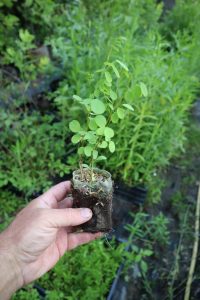Description

False indigo starter plant (Amorpha fruticosa) A tall (up to 12 ft) thicket forming shrub like plant that likes sunny to partially sunny waters edges, but will tolerate dry periods. Flowers are enjoyed by pollinators and several butterfly species will use as a host plant. Can be an an aggressive spreader. Somewhat similar look to lead plant, but lead plant is slow growing and prefers prairie like environments.
Note: These plants cannot be shipped to WA.
These are one year old plants that are up and growing for the 2024 season. The picture taken of the plant is a pot size indicator. They can be at various stages of growth through the season. If purchased early in the season they may be just coming up. In mid-season we may have cut them back for shipping purposes, Late in the season, they might showing signs of upcoming dormancy. Our plants have good roots which is the most important part for a successful native plant pollinator/ butterfly garden!
All of our plants are grown in biodegradable fabric pots. The containers are around 4″x4 1/2″ May be planted in the pot or removed . Generally, I like to take them off and compost them, but if you leave them on, I like to rip the sides or score them with a knife for easier root penetration.
Tips for growing:
As our plants are intended for pollinator gardens, they have not been treated with anything. Native plants don’t need any fertilizer, but if you want to lightly use an organic fertilizer, it won’t hurt.
The best place for our plants is in the ground. Do not grow in black plastic nursery pots “till they get bigger” Black plastic pots do not provide good aeration, get very hot, and will cause root circling and poor growth. Although being small, native plants often grow extensive root systems, often more than the visible foliage. When planted in the ground they will have the best chance to work on their roots.
When it comes to native perennials, roots are the most important part. While foliage can be an indicator of good growth, you want to give these plants the best chance for root growth. Don’t worry about flowering, it will come. Encourage roots!
We take care in packing our plants for shipping, but plants ocassionally get bent, broken stems in transit. This can appear disappointing, but they have good roots and will quickly recover.





